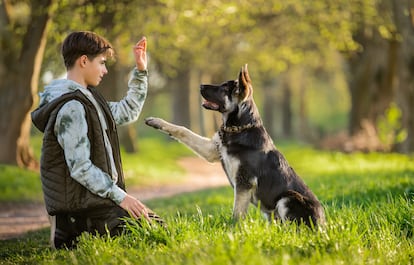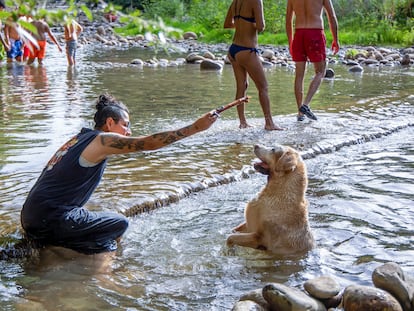Seven things I wish I had known before I got a dog
Hands up any first-time owner who has not been surprised by the effects of canine adolescence or floored by the enormous choice of supermarket food for their pet

When it comes to getting a dog, there is a big difference between theory and practice. You may research and learn some facts beyond the basics, such as that a dog needs several walks a day, a quiet place at home, and some toys to be able to happily chew without feeling guilty. You may know that dogs need a number of mandatory vaccinations, such as rabies, as well as optional but important shots, and that they should be dewormed at least every six months. But there are always issues that can catch first-time dog owners by surprise. Here is an overview of some, but not all of them.
Knowing the breed or type of dog is more important than you think
Before getting a dog, people usually think about its size, if it is long or short-haired, and if they want a puppy or an adult. The dog’s breed occasionally comes up, but usually just as a question of taste. Some people love the intelligence of the border collie, while others have been dreaming of having a Dalmatian for half their lives. Beyond that, however, each dog breed has specific needs that are important to consider. “You should never choose a dog breed because it is cute or because you know one particular specimen that you love. You have to really know which dog you are choosing as your companion, and take into account your lifestyle, the time and activity you are going to be able to dedicate to your pet, your personality, your experience with dogs, etc.”, explains María VetiCan, a veterinarian who shares tips to her more than 400,000 followers on TikTok and Instagram.
A person who loves sports and going out to the mountains every Sunday is not the same as someone who enjoys spending weekends at home. Nor is living in the center of a big city the same as living in a mountain village. “Often we think of getting a border collie or a Belgian Malinois, which is very popular right now. These are dogs that need a lot of activity but also a lot of tranquility. If we put them in an urban environment, with lots of stimulation, and then we try to stimulate them even more with the activity we know they need, we end up exhausting and overexciting them,” says Cristina González Cano, a veterinary ethologist in Barcelona. It is not a matter of not having a border collie in a city, but of combining our context with the dog’s needs and being aware of these needs in order to avoid problems.
Dog communication is nothing like what we think
No, licking is not like kissing, a dog smile is usually due to stress, and if it yawns when it is perfectly awake, it is more than likely not due to sudden sleepiness but a sign of calm. Dog communication is nothing like human communication, and it is still too common for us to confuse it. That’s why a little research and training in ethology — the science that studies the behavior of animals in their natural environment — can make things a lot easier. “Most of the time, if a dog doesn’t do something to our liking, it’s not because it doesn’t want to, but because we don’t know how to transmit the information properly, and therefore it doesn’t know how to do it. That’s why I strongly recommend to people taking a canine ethology and training course with their dogs, even if they don’t have behavioral problems yet. I think it is one of the best investments you can make,” says Maria VetiCan.
Dog adolescence is real
Not only is it real, but it is often very long. Just when you think your puppy is starting to calm down and seems to have internalized its training, adolescence arrives. According to the theory, it begins in small dogs at about four months and in larger breeds at six months. “You go from having a child, that’s sleepy, goofy and dependent, to having an adolescent who challenges you, runs away from you, ignores you, who is determining his place in the family and among other dogs, developing character, and of course, showing a new interest in the opposite sex and with revved up hormones,” explains María VetiCan.

Adolescence in dogs, like human adolescence, requires an enormous amount of patience. Only time can bring it to an end. It’s important to recognize that it’s also a difficult stage for the dog. “It is a time of confusion because there are no longer those concessions that big dogs sometimes make to puppies,” says González Cano. And those privileges sometimes end at home, too. “When he was a puppy and weighed 10 kilos, we let him climb onto the bed and the sofa and steal our socks because we thought it was funny. Now that he weighs 35 kilos we don’t want him to do it anymore, the dog doesn’t understand why, and it causes a lot of frustration and problems associated with a change of routines and regulations,” says González Cano.
Having a support network is key
It’s said that friendship is a treasure, and this is particularly true for friends will to take care of your dog. Indeed, this is especially important when it comes to vacations — paying someone to look after your dog can cost more than your very own holiday. And unforeseen events may also pop up that require you to travel, and unfortunately, traveling with a dog (especially if it is a big one) is still quite complicated. So, having friends, family or even a regular caregiver that the dog knows and feels comfortable with is a huge advantage.
Mental stimulation is as important as going for walks
When a dog is welcomed into the family, it’s understood that it will need to be taken out for walks. But it’s often forgotten that a dog needs more than that: it needs food, rest, play, exploration, social contact and safety. “The good thing about going for a walk is that it can cover many of these areas, exploration, sniffing, even searching for food if you introduce it, and social behavior,” explains González Cano. However, having stimulating activities at home is also important, especially for dogs that get overly excited on outings or, for example, on rainy days. These can range from sniffing games, where the animal looks for a reward, to building structures that force the dog to strategize to get food. “It is important to emphasize that this is always needed: in puppies, because it helps them get to know the world, as well as in adult dogs and senior animals as it prevents behavioral problems and helps slow down cognitive aging,” González Cano says.
The world of dog food is almost as varied as human food
There is an enormous range of dog food and diets. Some products promise to be low in cereals or monoproteic, while others say they are natural or hypoallergenic. The number of options can be overwhelming for first-time dog owners.
“Dogs are considered facultative carnivores, which means that their diet must be based on foods of animal origin, but they can obtain benefits from other foods such as fruits and vegetables as a source of vitamins, minerals and fiber,” explains María VetiCan.
On this basis, there are different diets such as, for example, grain-free diets. As Maria VetiCan explains, grains should not be the basis of their diet and many animals may not tolerate them. There are also natural diets that are “based only on the real needs of the animal,” explains the veterinarian. She warns that while this may be the best option, not everything counts as natural, meaning it “is easier to fail than to succeed.”

It’s a dog and it does dog things
This may seem obvious, but the truth is it can be quite difficult to accept, especially when “dog things” involve jumping into a muddy puddle or rolling in a dead animal. The latter behavior — common in hunting dogs — “is a normal behavior and is usually done as a disguise,” explains González Cano. “It’s what they do to cover up their own scent so they resemble the other animal.”
Another common behavior is for dog to eat feces, human or otherwise. “There can be other causes, including medical causes, but generally it is a misdirected exploratory behavior,” says González Cano.
When you have a dog, you discover that, especially in parks and children’s areas, there is more human feces than you ever imagined, and your dog may find them to be a real delicacy, as in the case of human or cat feces. “For us, it is disgusting and dangerous as you don’t know what parasites and bacteria your animal is ingesting, but for the dog, it is the most normal thing in the world and the most fun thing to do on the planet,” she says.
Sign up for our weekly newsletter to get more English-language news coverage from EL PAÍS USA Edition
Tu suscripción se está usando en otro dispositivo
¿Quieres añadir otro usuario a tu suscripción?
Si continúas leyendo en este dispositivo, no se podrá leer en el otro.
FlechaTu suscripción se está usando en otro dispositivo y solo puedes acceder a EL PAÍS desde un dispositivo a la vez.
Si quieres compartir tu cuenta, cambia tu suscripción a la modalidad Premium, así podrás añadir otro usuario. Cada uno accederá con su propia cuenta de email, lo que os permitirá personalizar vuestra experiencia en EL PAÍS.
¿Tienes una suscripción de empresa? Accede aquí para contratar más cuentas.
En el caso de no saber quién está usando tu cuenta, te recomendamos cambiar tu contraseña aquí.
Si decides continuar compartiendo tu cuenta, este mensaje se mostrará en tu dispositivo y en el de la otra persona que está usando tu cuenta de forma indefinida, afectando a tu experiencia de lectura. Puedes consultar aquí los términos y condiciones de la suscripción digital.
More information
Últimas noticias
From digital curfews to blocking apps: How technology experts protect their children online
Why the price of coffee has skyrocketed: from Brazilian plantations to specialty coffee houses
Confined to a Cuban hospital: When electricity is a matter of life or death
Pinochet’s victims grapple with José Antonio Kast’s rise in Chile
Most viewed
- Pablo Escobar’s hippos: A serious environmental problem, 40 years on
- Reinhard Genzel, Nobel laureate in physics: ‘One-minute videos will never give you the truth’
- Why we lost the habit of sleeping in two segments and how that changed our sense of time
- Charles Dubouloz, mountaineering star, retires at 36 with a farewell tour inspired by Walter Bonatti
- The Florida Keys tourist paradise is besieged by immigration agents: ‘We’ve never seen anything like this’











































